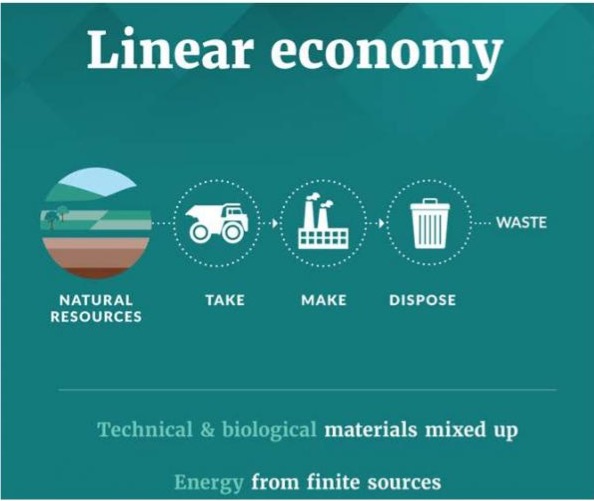
Did you know that 90% of the resources we currently use become waste, rather than returning to production cycles? It’s widely agreed that our consumption and waste generation must reduce quickly as demand for resources increases.
By 2030, it’s estimated that the world’s yearly demand for resources will equal twice the amount that can be replaced naturally by Earth, and three times as much by 2050. In this article, we will explain what is being done to reverse the trend and how data plays an enormous role in promoting a circular economy. Specifically, we outline three steps for businesses to understand how they can use data to become more circular and promote sustainability.
Take-Make-Dispose Approach
Why do people consume so many natural resources? And why does such a large percentage of the resources people consume become waste? A main driver is our current “take-make-dispose” approach to production and consumption we’ve seen emerge since the industrial revolution. We take raw materials from the earth, use them to make and sell products and, often after a single use, dispose of them as waste. This is the linear economy, and it has proven to be unsustainable in both resource consumption and environmental impact.

The current economic model of “take, make, dispose” means many goods end up in landfills as waste, demonstrating a linear economy as opposed to a circular approach
Source: Ellen Macarthur FoundationCircular Economy Proposition
An alternative model has begun to take hold in business and government, known as the circular economy. The circular economic model follows three principles that prioritize sustainable consumption and overall waste reduction over strictly profit growth:
Design out waste and pollution
Keep products and materials in use
Regenerate natural systems

The circular economy is a model to extend the life cycle of products by reusing, repairing, refurbishing and recycling existing materials and products
Source: World Economic ForumThe shift to a circular economy does not equate to a decline in economic growth. In fact, according to the World Economic Forum, the circular economy has the potential to yield up to $4.5 trillion in economic benefits by 2030. As consumer preferences, government action, and technology advancements continue to shift in the favor of sustainability, companies have found that there are many sources of value within the minimum-waste paradigm, but often lack the data and insights to identify and unlock them.
Therefore, many companies are investing in setting up the discipline of data and analytics specifically to address waste. By collecting and using data related to their production and consumption cycles, with each of the three circular economy principles in mind, innovative organizations in every industry have uncovered opportunities to move towards more profitable, sustainable business models. The following three principles – taking inventory, implementing existing best practices, and exploring novel opportunities – are recommended to prioritize sustainable consumption while meeting the needs of the business.
Design out Waste and Pollution
Data can help companies make decisions that minimize the amount of waste and pollution entering the consumer ecosystem at the onset, from choosing the right toothpaste packaging to better materials for buildings. Using data sources such as an input’s origin and utility, historical customer behavior, and design parameters, producers can build models and run simulations to find the least wasteful design for their products.
Designing out waste goes further than modelling buildings and selecting the best packaging for hygienic product; for those that don’t manufacture physical goods, the same principles apply. In 2018, Google developed a machine learning model to decrease energy usage within data centers. After crunching data sources that have been available for years, such as outside air temperature and power load, in an innovative way, they were able to reduce the amount of energy used to cool their data centers by as much as 40%. Oftentimes, the right data is already available, but just not being used for an innovative purpose.
Keep Products and Materials in Use
Enabling raw materials, products, and components to be kept in use at their highest possible value is a key tenant of the circular economy. Key data such as material supply and demand, consumer behavior, and material durability can help in extending resource life, from finding the best new home for your scrap metal to setting up optimally placed shampoo refill stations.
Pioneering companies across the globe are using data to promote the reuse and recycling of resources using digital marketplaces. Rheaply, a Chicago-based resource exchange platform, partners with academic institutions, corporations, and even cities to take inventory of and reuse their physical assets. Three days after joining the Rheaply platform in 2019, the University of Chicago prevented $700,000 in research supply from being landfilled by connecting them with optimal buyers for their resources. Companies can also use data from materials marketplaces (and other data-sharing platforms) to estimate the amount of non-virgin material they can source and reduce their purchase of raw materials accordingly.
Retailers have many avenues to promote extended product usage using data as well. One great example is a shift away from the single-use business model by way of refills and returns. By tagging durable products throughout their life and monitoring customer behavior, retailers can optimize their refill and return approach. Refill-on-the-go, where shoppers can refill their containers through dispensing systems at the store, reduces both waste and manufacturing costs for producers. By tracking what customers are refilling the most and how many uses certain products accumulate, companies can make informed decisions when refining their circular strategy.
Regenerate Natural Systems
When shifting our focus from extraction to regeneration, we can begin to use data to imitate natural systems. Monitoring the health levels of the environment, sourcing inputs from regenerative suppliers, and using the highest percentage of renewable energy possible in operations will ensure that companies play an active role in allowing nature to thrive.
One of the biggest advantages of adopting a circular business model occurs as a result of being successful in the first two principles. By keeping products and materials in use and designing out waste, we can decrease the need for raw-material extraction. This leaves more land that can be left for nature to regenerate on its own. It also results in avoided emissions and waste for companies that can show progress over time. Having the data to measure waste and pollution generation allows corporations to not only comply with increasingly stringent regulations but also to compare (and share) the effects of positive actions with partners and the public.
3-Step Approach for Using Data to Promote Sustainability
Whatever the industry of your company, data can be utilized to help design out waste, keep materials in use, and promote regeneration. Our recommended, three-step approach to using data to become more circular can be found below.
1. Take Inventory: Identify Current Tools and Data for Your Business to Track Waste Generated
Key questions:
How much waste and pollution does your company generate each year?
What tools exist to help you track the inputs and outputs of your business?
What sources of data outside of your core operations impact the amount of waste and pollution you generate?
2. Implement Existing Best Practices: Understand the Current People, Processes, and Technology to Use Your Data
Key questions:
What processes can you automate, and what tools and technology solutions exist that can help you use your data to do so?
What amount of renewable energy and extended-life inputs does your data suggest you can incorporate into your operations?
What resources do you need to pull and implement insights from your data?
3. Explore Novel Opportunities: Plan Ahead with Your Strategic Roadmap to Address Future Data Needs
Key questions:
What markets can you enter to sell your waste or buy recycled/refurbished inputs, and how does that affect your strategic roadmap?
What shifts in your business model will allow for your outputs to be reused, refurbished, or remanufactured, based on your data?
What expertise are you missing, and who can you partner with that has the knowledge or capabilities you need?
Looking Forward
No matter how efficient we become, it’s an unavoidable truth that our planet has limited resource availability. In order to support the World’s estimated 9.8 billion people in 2050, new practices and new technologies will have to be implemented at scale – with useful data at the core.
Credera leverages its technology experience to advise organizations on how to unlock the power of their data for novel uses. If you’d like to have a conversation about moving your organization towards data-driven circularity, please reach out at marketing@credera.com.
Contact Us
Let's talk!
We're ready to help turn your biggest challenges into your biggest advantages.
Searching for a new career?
View job openings




